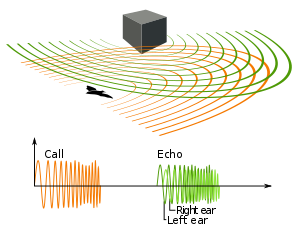Have you ever been walking through your house in the middle of the night with all the lights off, searching for a glass of water, but you feel an intense pain running through your body as you stub your toe on the counter? This would never happen if humans had echolocation: the ability to map out the area ahead of you by using reflections from high-pitched sonar signals.

Animal Echolocation
Credit: WikiMedia
Echolocation is an ability that is primarily used by dolphins and bats. This raises the question, why is it that dolphins: hairless mammals which live in the ocean, happen to have the same specialized ability as bats: which are furry, nocturnal, and flying critters?
Dolphins utilise a unique organ called the melon to send out high frequency clicks. They have a large depression in their skull to make space for this organ, allowing them to produce bisonar for orientation. Beyond this, echolocation gives dolphins an idea on the object’s shape and size, although it is not quite understood by scientists exactly how this happens.

Bisonar by cetaceans
Credit: Wikimedia
Bats dominantly use a method of echolocation called laryngeal echolocation, which is characterized by the production of very short wavelength sounds from their larynx. The connection between their stylohyal bone and tympanic bone enables the bat to neurally register and separate outgoing and incoming ultrasonic waves. They have evolved to differentiate between the pulses they produce and the echoes that they receive back.

Ventral view of the Florida Freetail bat, highlighting the tympanic and stylohal bones. Credit: Pacific Lutheran University Natural History
This skill could potentially be relevant for humans today, as researchers are using this skill to test human echolocation in blind people. It has been revealed that some blind people were able to independently develop a type of echolocation, by utilising sound, they are able to map out the space they are in and develop an image of it for themselves. Some researchers are studying this ability, attempting to make it accessible for all who might need it.
So how is it that dolphins and bats have developed these extremely similar skills? Clearly, there is the fact that because dolphins hunt in murky ocean waters, and bats hunt late at night in the dark. Thus they both had to have evolved some method to cope with the darkness, but why was it that they developed the same method of echolocation independently? A team of scientists were trying to answer this question, and a paper in Science Advances announced that there exist genetic characteristics that could have helped dolphins and bats both develop this skill.
This international group of scientists searched through the genomes of each animal, searching side by side for any similarities in amino acid sequences. They found that bats and dolphins share amino acids linked to proteins involved in the development of a very specific set of fast-twitch muscles. These were the muscles that drive the “terminal buzz”, or the rapid high frequency calls that bats and dolphins both make when hunting.

Figure showing sudden increase in high frequency calls in a bat
Credit: The Gall Lab
Audio clip: Adobe Flash Player (version 9 or above) is required to play this audio clip. Download the latest version here. You also need to have JavaScript enabled in your browser.
Sound clip of terminal buzz – the terminal buzz is the last pulses of an echolocation call sequence: and will speed up at the end because the bat is getting closer to the object it is interested in.
Credit: The Gall Lab
This similarity in amino acid sequence may be a part of what helped these two very different animals develop the same skill, but there is still plenty to uncover about the specifics of how dolphins and bats developed echolocation independently. However, we are much closer to uncovering this mystery than in the past.
Jin Kyu Lee
